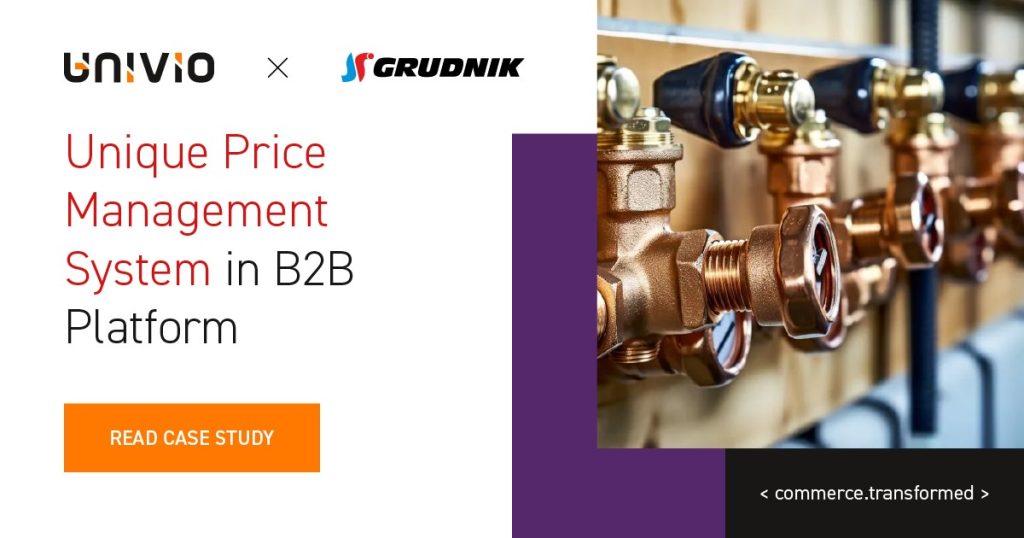Digital Transformation in the Building Materials Industry
The construction industry has not escaped the digital revolution. On one hand, we have the pressures of EU legislation and, on the other, the enormous opportunities that such new technologies bring. What innovations can become a critical success in this sector? Let’s check out the most important building materials industry digitalization trends!
The Building Materials Sector Needs Digitization
Companies in the construction industry admit that they have a lot of work to do when it comes to digitizing and implementing new technologies. And when it comes to construction materials, it’s certainly no different. Manufacturers and suppliers in construction materials market have long relied on traditional sales models. Salespeople were – and often still are – responsible for specific regions, building relationships with distributors, organizing technical training at distribution points and manually preparing special offers for valuable partners. These activities, while often yielding great results, are difficult to scale. Companies would need to hire an infinite number of salespeople, which, of course, isn’t possible with finite budgets.
There are also many generational changes that are irreversible. Contractors want to buy building products online, as it enables them to act faster. The subsequent need for digitization in construction materials market is a truth that’s well understood amongst major players in the industry. And while actions are being taken to develop their presence in the online world, this process is unfortunately less dynamic during crises, when savings have to be sought.
Despite this, we can still find many examples of companies that are successfully implementing digital solutions in different areas of their business. SIG, a distributor of building materials, has seen greater sales efficiency, with a 142% increase in revenue, after implementing their omnichannel model. Pneumat Systems, likewise, experienced a 125% increase in revenue from its online channel after implementing a B2B platform.

These are not the only organizations investing in digital solutions. Other interesting and innovative examples include Saint-Gobain, which is developing 3D printing technology using special concrete, or Selena, whose R&D department is successfully developing raw materials based on natural sources that strongly reduce the carbon footprint.
How Legislation is Mobilizing Digital Transformation in the Construction Industry
These building materials industry trends are not only borne out of the ubiquitous need for digitization.
European legislation is also another critical factor that is spurring the construction material industry into action.
Construction Products Regulation (CPR)
Intended to enable the free movement of construction materials within the EU, the CPR directive establishes uniform rules for the introduction of such products. It provides a common technical language evaluating the performance of construction goods. Companies therefore need to adapt their processes and product information to meet these new standards with appropriate tools.
Environmental Product Declaration (EPD)
Designed to present transparent, standardized information on product life-cycle environmental impact, the Environmental Product Declaration is a document that takes into account the entire life cycle of the goods in question. This includes raw material acquisition, energy intensity during production, transportation, intended use and recycling possibilities.
Construction goods with EPDs are more likely to be chosen for green building projects that seek sustainable materials and certifications. This again leads building materials companies to look for means, often using innovative technologies, to optimize all the processes described in the EPD.
ESG Reporting
Starting in 2023, large, listed companies – defined as those with over €500 million in annual turnover or with 500+ employees – must undertake and disclose their ESG reporting. Such reporting present’s a company’s data on their environmental, societal, and corporate governance (ESG for short). 98% of managers take ESG data into account in their decision-making processes, and companies that do not comply with sustainability rules face losing large contracts and/or worse loan rates as a result.
Reducing environmental impact therefore continues to be one of the most critical building materials industry trends, and technology is providing a helping, innovative hand. With market growth and digitalization, construction companies are getting deeper and deeper into the various aspects of their business to find any and all potential improvements.
How is Technology Changing the Building Materials Industry?
New technologies are evolving the building products market on many different levels. At every stage of product development, from R&D to product launches, technology is making a strong presence in materials market.
The industry is rapidly taking advantage of the Internet of Things (IoT), including robots and sensors to improve and optimize manufacturing processes. Artificial intelligence algorithms are being implemented into sales and operations planning (S&OP) with increasingly bold abundance, enabling companies to more accurately forecast production demand.
Organizations that produce construction materials can also feed BIM (Building Information Management) systems with essential product information, such as carbon footprints. BIM systems make it easier for architects to create different construction projects options, pricing or even estimates of a given building’s carbon footprint. The last factor is extremely important because, as we already know, investors and clients alike are turning to green buildings in greater and greater numbers.
Logistics is also another rapidly changing area. For contractors, it is essential that materials arrive at construction sites complete and on time. Companies are therefore implementing On-Time-In-Full solutions to optimize the operation of distribution centers and enable specific amounts of materials to be ordered to construction sites on a given day. This is an incredible and necessary convenience for such locations, where storage space is hard to come by.
Are there any other areas of digital transformation that influence this industry? As you can see above, there are plenty, but we’re only focusing on the construction materials industry trends that we know best. 😉
The Digitization of Sales
The building materials industry is still dominated by sales at marketplaces, wholesalers and specialized construction material market stores. When facing problems or queries about products, contracts turn directly to the point of sale, where expert staff (often trained by product companies) are able to help and provide the necessary information.
Even so, many reports clearly indicate that sales channels and methods predominantly associated with B2C sectors are becoming more common in B2B as well. Customers in this latter sector increasingly expect the same convenience and solutions they encounter in B2C businesses. Even today, 49% of all B2B spending takes place online and this is predicted to increase to 57% in only 5 years.
However, when transforming sales in this way, the construction industry must take into account the specific nuances of how its own sector operates.
Convenience for the End Customer
Customers in the construction sector want to order products 24/7 and quickly get information about their availability in given locations. They also expect e-commerce platforms to be intuitive and simple to use. Advanced search engines are an effective means to achieve this, as they enable users to quickly find a product in a variety of ways.

B2B customers also expect convenient access to special business terms. Dedicated B2B e-commerce platforms, for example, have the option of two-stage access to the site. This allows products to be displayed with their list price, which is useful in the likes of D2C situations where goods are shown directly to the public consumer. The second level of access, on the other hand, is reserved for business customers and contains individual terms, prices and delivery costs unique to them.
Business Relationship Support
In the building materials industry, it’s very important to build strong relationships between traders and business partners. These are often developed over multiple years, during regular in-person meetings, as well as through events held for contractors and distributors.
Naturally, traders raise concerns about the necessity of their own roles when discussing e-commerce platforms in the construction industry, but their fears are completely unnecessary! E-commerce systems automate and simplify many activities, easing the burden originally placed on salespeople. Rather than being replaced, they can more easily access customer histories, place orders on behalf of their clients, create quotes faster, segment customers as needed and even assign tasks to other members of the sales team.
As a result of all this, the sales department can devote the time regained through automation to deepening relationships with key customers and looking for new sales opportunities.

Product Management
Companies that specialize in the manufacturing and distribution of construction materials are acutely aware of Product Information Management (PIM) tools and their foundation for successful sales. However, they often lack the internal competence or time to feed such systems with the necessary information.
According to some reports, only 13% of building materials companies have implemented PIM systems. So, it’s clear that this is an area that still needs improvement. With hundreds of products, different distribution and sales channels, a Single Source of Truth is essential for effective product management. It is then easier, with such a system, to launch sales in a marketplace, for example, or even launch multichannel or omnichannel sales models.
A single PIM system enables consistency, as it automates description changes across the board and eliminates any errors due to manual work. It’s not uncommon for different departments to be responsible for different segments and product groups. Without a centralized tool, it’s easier for errors and inconsistent communication to creep in regarding product differentiators and their strengths.
A PIM also speeds up the creation of product catalogs, which are a very important part of marketing efforts in this industry. Preparing such materials without a common product base can take up to a dozen months of gathering the right descriptions, fine-tuning content and undertaking multiple rounds of approval.

Launching Sales in the Marketplace
Marketplaces are becoming increasingly popular, as made evident by Amazon, which receives nearly 5 billion visits each month. Customers want to conveniently search for the best deals and order various products in one place. For companies, this is a chance to reach a different customer segment, take advantage of a simplified sales process and gain even greater marketing opportunities.
Many major building material companies are already present in such marketplaces. Sika, for example, has an official store on Amazon, while Tytan Professional can also be found on Allegro (a very popular marketplace here in Poland). Interestingly, we’re also witnessing the emergence of marketplaces dedicated solely to the building materials industry. This one of the rapidly developing construction materials industry trends worth watching and considering as part of a future sales strategy.
Digital Transformation Brick-by-Brick
When it comes to digital transformation in the building materials industry, progress is steady. In some cases it is faster, and sometimes it is slower but either way, companies are fortunately realizing the critical role that technology plays in improving businesses at various levels. And realizing the need for change is already the first step towards actually implementing that change. The next step may be to prioritize and decide which areas are the most strategically important. You should also consider whether the digital transformation can be carried out by your own efforts, or whether it’s necessary to enlist the help of a proven expert partner.
Whatever the decision, it’s better not to put off change and build your competitive advantage brick-by-brick with innovative technology.







